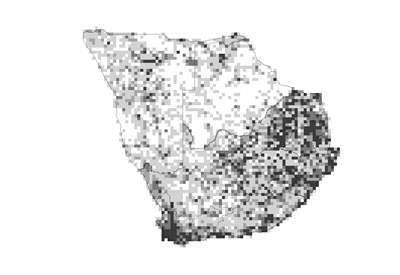 Species distribution and density. Darker squares represent higher density of members of this family. |
Introduction
Grass family
The virtues of grasses have been sung by many through the ages. People and animals are totally dependent on the numerous species grown as crops and fodder. It is not until you delve deeper that you start appreciating the beauty of the spikelets, their hairs, awns and their sculpturing that create the amazing differences between genera and species. In southern Africa, eight subfamilies are recognised.
Distribution
Grasses occur worldwide and throughout southern Africa. Locally the family has higher densities on the Highveld and in the warmer areas, but different combinations of species are found in the Western Cape.
Number of genera in the world
600
Number of species in the world
9 000-10 000
Number of genera in the Flora of southern Africa region
200
Number of species in the Flora of southern Africa region
1 016
Well-known southern African genera
Digitaria, Eragrostis, Panicum, Setaria, Sporobolus, Themeda
Subclasification
1. Subfamily Panicoideae
The subfamily has 71 genera and 327 species in southern Africa. It is subdivided into 5 tribes in FSA (Isachneae, Arundinelleae, Paniceae, Andropogoneae and Maydeae). Ligule a short membrane, a fringe of hairs or a fringed membrane; inflorescence a panicle or unilateral raceme; spikelets generally all alike, with 2 florets, bisexual, articulate below the glumes, lower glume shorter than the spikelet. In the tribe Andropogoneae spikelets are paired (different from each other, one often sessile and one pedicellate) and the inflorescence is usually a leafy false panicle.
Well-known FSA genera: Alloteropsis, Andropogon, Brachiaria, Cenchrus, Cymbopogon, Digitaria, Hyparrhenia, Melinis, Panicum, Setaria, Themeda.
2. Subfamily Chloridoideae
The subfamily has 51 genera and 241 species in southern Africa. It is subdivided into 2 tribes in FSA (Pappophoreae, Triodieae). Ligule membranous or a line of hairs (rarely a fringed membrane); inflorescence often with unilateral racemes, 1-many-flowered; spikelets laterally compressed, lemmas 1-3-nerved.
Well-known FSA genera: Chloris, Cynodon, Enneapogon, Eragrostis, Pogonarthria, Sporobolus, Tragus.
3. Subfamily Pooideae
The subfamily has 45 genera and 144 species in southern Africa. It is subdivided into 7 tribes in FSA. Ligule membranous; inflorescence a panicle; spikelets 1-many-flowered and laterally compressed, with or without an apical or dorsal awn.
Well-known FSA genera: *Agrostis, *Briza, Bromus, Festuca, Helictotrichon, *Hordeum.
4. Subfamily Danthonioideae
The subfamily has 11 genera and 124 species in southern Africa. Ligule a line of hairs; inflorescence a panicle; lateral and/or central awns present.
Well-known FSA genera: Chaetobromus, Merxmuellera, Pentameris, Tribolium.
5. Subfamily Aristidoideae
The subfamily has 3 genera and 79 species in southern Africa. Ligule a line of hairs; inflorescence a panicle; spikelets 3-awned, awns bare or with plumes.
Well-known FSA genera: Aristida, Stipagrostis, Sartidia.
6. Subfamily Ehrhartoideae
The subfamily has 5 genera and 43 species in southern Africa. Ligule membranous; inflorescence a panicle or unilateral raceme; spikelets often unconventional and the structure difficult to interpret.
Well-known FSA genera: Ehrharta, Leersia, Oryza, Prosphytochloa.
7. Subfamily Arundinoideae
The subfamily has 5 genera and 8 species in southern Africa. Reed-like; ligule membranous with ciliate margin; inflorescence a panicle.
Well-known FSA genera: *Arundo, Phragmites, Dregeochloa, Elytrophorus.
8. Subfamily Bambusoideae
The subfamily has 4 genera and 4 species in southern Africa. Plants generally woody trees, shrubs or climbers; spikelets with 3-6 stamens and 1-3 stigmas.
Well-known FSA genera: Thamnocalamus, *Bambusa, Oxytenanthera, Olyra.
Growth forms
Annual or perennial herbs, usually tufted and often with a rhizome, rarely woody and tree-like (bamboo).
Habitats
Almost everywhere, from forest, open grassland, to the desert and the coast, on all types of soils and in all moisture conditions.
Flagship species
The genus Themeda is well known despite the fact that is has only one species. Themeda triandra (red grass; rooigras [A]; iNsinde [Z]) is generally regarded as a desirable grass for grazing and can disappear quickly if the veld is not well managed. It is widely distributed, except in the dry areas of the Northern Cape. This distribution contributes to the very large variation in the species.
Significance of the family
The major importance of grasses is to provide grazing for animals and food for humans, but it has numerous other uses, for example, in horticulture as ornamentals and lawns, in the construction industry as building material, in the decorative industry as furniture and flooring and in the textile industry as a source of fibre. Some of the more important species are: barley (*Hordeum vulgare), a nutritious cereal, also used as animal fodder and for brewing beer; rice (*Oryza sativa) provides high-energy starch; sugar cane (*Saccharum officinarum) is used as sweetener; maize products (*Zea mays) are a staple food in many countries. Seed necklaces of *Coix lacryma-jobi have traditionally been used in Zulu culture as protective charms and in teething rings for babies.
Diagnostic characters
Herbaceous; culms usually hollow , cylindrical or compressed, with obvious nodes � and internodes. Leaves with blades and leaf sheaths , with ligules �. Inflorescences at the tip of the culms . Flowers borne in spikelets .
Did you know?
Three cereals (rice, wheat and maize) provide more than half of all calories consumed by humans.